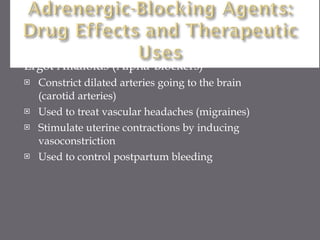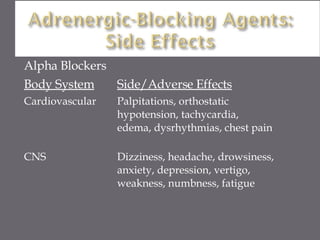03 Adrenergic Blockers Upd
- 1. Adrenergic Agents and Adrenergic-Blocking Agents
- 3. Drugs that stimulate the sympathetic nervous system (SNS)
- 4. Also known as adrenergic agonists or sympathomimetics
- 5. Mimic the effects of the SNS neurotransmitters: norepinephrine (NE) and epinephrine (EPI)
- 6. Located throughout the body Are receptors for the sympathetic neurotransmitters Alpha-adrenergic receptors: respond to NE Beta-adrenergic receptors: respond to EPI
- 7. Divided into alpha1 and alpha 2 receptors Differentiated by their location on nerves
- 8. Located on postsynaptic effector cells (the cell, muscle, or organ that the nerve stimulates)
- 9. Located on presynaptic nerve terminals (the nerve that stimulates the effector cells) Control the release of neurotransmitters
- 10. Vasoconstriction and CNS stimulation
- 11. All are located on postsynaptic effector cells Beta 1 -adrenergic receptors—located primarily in the heart Beta 2 -adrenergic receptors—located in smooth muscle of the bronchioles, arterioles, and visceral organs
- 12. Bronchial, GI, and uterine smooth muscle relaxation Glycogenolysis Cardiac stimulation
- 13. An additional adrenergic receptor Stimulated by dopamine Causes dilation of the following blood vessels, resulting in INCREASED blood flow Renal Mesenteric Coronary Cerebral
- 14. LOCATION RECEPTOR RESPONSE Cardiovascular Blood vessels alpha 1 and beta 2 Constriction / dilation Cardiac muscle beta 1 Increased contractility AV Node beta 1 Increased heart rate SA Node beta 1 Increased heart rate
- 15. LOCATION RECEPTOR RESPONSE Gastrointestinal Muscle beta 2 Decreased motility Sphincters alpha 1 Constriction
- 16. LOCATION RECEPTOR RESPONSE Genitourinary Bladder alpha 1 Constriction sphincter Penis alpha 1 Ejaculation Uterus alpha 1 and beta 2 Contraction/ relaxation
- 17. LOCATION RECEPTOR RESPONSE Respiratory Bronchial beta 2 Dilation/relaxation muscles
- 18. Substances that can produce a sympathomimetic response Endogenous: epinephrine, norepinephrine,dopamine Synthetic: isoproterenol, dobutamine, phenylephrine
- 19. Direct-acting sympathomimetic: Binds directly to the receptor and causes a physiologic response
- 21. Indirect-acting sympathomimetic: Causes the release of catecholamine from the storage sites (vesicles) in the nerve endings The catecholamine then binds to the receptors and causes a physiologic response
- 23. Mixed-acting sympathomimetic: Directly stimulates the receptor by binding to it AND Indirectly stimulates the receptor by causing the release of stored neurotransmitters from the vesicles in the nerve endings
- 25. Stimulation of alpha-adrenergic receptors on smooth muscles results in: Vasoconstriction of blood vessels Relaxation of GI smooth muscles Contraction of the uterus and bladder Male ejaculation Decreased insulin release Contraction of the ciliary muscles of the eye (dilated pupils)
- 26. Stimulation of beta 2 -adrenergic receptors on the airways results in: Bronchodilation (relaxation of the bronchi) Uterine relaxation Glycogenolysis in the liver
- 27. Stimulation of beta1-adrenergic receptors on the myocardium, AV node, and SA node results in CARDIAC STIMULATION: Increased force of contraction (positive inotropic effect) Increased heart rate (positive chronotropic effect) Increased conduction through the AV node (positive dromotropic effect)
- 28. Anorexiants: adjuncts to diet in the short-term management of obesity Examples: benzphetamine phentermine dextroamphetamine Dexedrine
- 29. Bronchodilators: treatment of asthma and bronchitis Agents that stimulate beta 2 -adrenergic receptors of bronchial smooth muscles causing relaxation Examples: albuterol ephedrine epinephrine isoetharine isoproterenol levalbuterol metaproterenol salmeterol terbutaline These agents may also affect uterine and vascular smooth muscles.
- 30. Reduction of intraocular pressure and mydriasis (pupil dilation): treatment of open-angle glaucoma Examples: epinephrine and dipivefrin
- 31. Nasal decongestant: Intranasal (topical) application causes constriction of dilated arterioles and reduction of nasal blood flow, thus decreasing congestion. Examples: epinephrine ephedrine naphazoline phenylephrine tetrahydrozoline
- 32. Ophthalmic Topical application to the eye surface affects the vasculature of the eye, stimulating alpha receptors on small arterioles, thus relieving conjunctival congestion. Examples: epinephrine naphazoline phenylephrine tetrahydrozoline
- 33. Vasoactive sympathomimetics (pressors, inotropes), also called cardioselective sympathomimetics Used to support the heart during cardiac failure or shock. Examples: dobutamine dopamine ephedrine epinephrine fenoldopam isoproterenol methoxamine norepinephrine phenylephrine
- 34. Alpha-Adrenergic Effects CNS: headache, restlessness, excitement, insomnia, euphoria Cardiovascular: palpitations (dysrhythmias), tachycardia, vasoconstriction, hypertension Other: anorexia, dry mouth, nausea, vomiting, taste changes (rare)
- 35. Beta-Adrenergic Effects CNS: mild tremors, headache, nervousness, dizziness Cardiovascular: increased heart rate, palpitations (dysrhythmias), fluctuations in BP Other: sweating, nausea, vomiting, muscle cramps
- 36. Anesthetic agents Tricyclic antidepressants MAOIs Antihistamines Thyroid preparations Antihypertensives Will directly antagonize another adrenergic agent, resulting in reduced effects
- 37. Assess for allergies and history of hypertension, cardiac dysrhythmias, or other cardiovascular disease. Assess renal, hepatic, and cardiac function before treatment. Perform baseline assessment of vital signs, peripheral pulses, skin color, temperature, and capillary refill. Include postural blood pressure and pulse. Follow administration guidelines carefully.
- 38. IV administration: Check IV site often for infiltration Use clear IV solutions Use an infusion device/IV pump Infuse agent slowly to avoid dangerous cardiovascular effects Monitor cardiac rhythm
- 39. With chronic lung disease: Instruct patients to avoid factors that exacerbate their condition. Encourage fluid intake (up to 3000 mL per day) if permitted. Educate about proper dosing and equipment care. Salmeterol is indicated for PREVENTION of bronchospasms, not management of acute symptoms.
- 40. Overuse of nasal decongestants may cause rebound nasal congestion or ulcerations. Avoid OTC or other medications because of possible interactions. Administering two adrenergic agents together may precipitate severe cardiovascular effects such as tachycardia or hypertension. Inform patients taking inhaled isoproterenol that their sputum or saliva may turn pink.
- 41. Monitor for therapeutic effects (cardiovascular uses): Decreased edema Increased urinary output Return to normal vital signs Improved skin color and temperature Increased LOC
- 42. Monitor for therapeutic effects (asthma): Return to normal respiratory rate Improved breath sounds, fewer rales Increased air exchange Decreased cough Less dyspnea Improved blood gases Increased activity tolerance
- 43. Bind to adrenergic receptors, but inhibit or block stimulation of the sympathetic nervous system (SNS)
- 44. Have the opposite effect of adrenergic agents Also known as adrenergic antagonists or sympatholytics
- 45. Sympatholytics inhibit—or LYSE—sympathetic neurotransmitters (norepinephrine and epinephrine)
- 46. Classified by the type of adrenergic receptor they block Alpha 1 and alpha 2 receptors Beta 1 and beta 2 receptors
- 48. Ergot Alkaloids (Alpha-Blockers) Constrict dilated arteries going to the brain (carotid arteries) Used to treat vascular headaches (migraines) Stimulate uterine contractions by inducing vasoconstriction Used to control postpartum bleeding
- 49. Alpha-Blockers Cause both arterial and venous dilation, reducing peripheral vascular resistance and BP Used to treat hypertension Effect on receptors on prostate gland and bladder decreased resistance to urinary outflow, thus reducing urinary obstruction and relieving effects of BPH
- 50. Alpha-Blockers Phentolamine Quickly reverses the potent vasoconstrictive effects of extravasated vasopressors such as norepinephrine or epinephrine. Restores blood flow and prevents tissue necrosis.
- 51. Alpha Blockers Body System Side/Adverse Effects Cardiovascular Palpitations, orthostatic hypotension, tachycardia, edema, dysrhythmias, chest pain CNS Dizziness, headache, drowsiness, anxiety, depression, vertigo, weakness, numbness, fatigue
- 52. Alpha Blockers Body System Side/Adverse Effects Gastrointestinal Nausea, vomiting, diarrhea, constipation, abdominal pain Other Incontinence, nose bleeding, tinnitus, dry mouth, pharyngitis, rhinitis
- 53. Block stimulation of beta receptors in the SNS Compete with norepinephrine and epinephrine Selective and nonselective beta blockers
- 54. Beta 1 Receptors Located primarily on the heart Beta blockers selective for these receptors are called cardioselective beta blockers
- 55. Beta 2 Receptors Located primarily on smooth muscles of bronchioles and blood vessels
- 56. Beta blockers that block both beta 1 and beta 2 receptors
- 57. Cardioselective (Beta1) Decreases heart rate Prolongs SA node recovery Slows conduction rate through the AV node Decreases myocardial contractility, thus decreasing myocardial oxygen demand
- 58. Nonspecific (Beta 1 and Beta 2 ) Effects on heart: Same as cardioselective Bronchioles: Constriction, resulting in narrowing of airways and shortness of breath Blood vessels: Vasoconstriction
- 59. Anti-angina: decreases demand for myocardial oxygen Cardioprotective: inhibits stimulation by circulating catecholamines Class II antidysrhythmic
- 60. Antihypertensive Treatment of migraine headaches Glaucoma (topical use)
- 61. Body System Side/Adverse Effects Blood Agranulocytosis, thrombocytopenia Cardiovascular AV block, bradycardia, congestive heart failure, peripheral vascular insufficiency CNS Dizziness, mental depression, lethargy, hallucinations
- 62. Beta Blockers Body System Side/Adverse Effects Gastrointestinal Nausea, dry mouth, vomiting, diarrhea, cramps, ischemic colitis Other Impotence, rash, alopecia, bronchospasms
- 63. Assess for allergies and history of COPD, hypotension, cardiac dysrhythmias, bradycardia, CHF, or other cardiovascular problems Any preexisting condition that might be exacerbated by the use of these agents might be a CONTRAINDICATION to their use.
- 64. Remember that alpha blockers may precipitate hypotension. Remember that beta blockers may precipitate bradycardia, hypotension, heart block, CHF, and bronchoconstriction.
- 65. Avoid OTC medications because of possible interactions. Possible drug interactions may occur with: Antacids (aluminum hydroxide type) Antimuscarinics/anticholinergics Diuretics and cardiovascular drugs Neuromuscular blocking agents Oral hypoglycemic agents
- 66. Encourage patients to take medications as prescribed. These medications should never be stopped abruptly. Report constipation or the development of any urinary hesitancy or bladder distention.
- 67. Teach patients to change positions slowly to prevent or minimize postural hypotension. Avoid caffeine (excessive irritability). Avoid alcohol ingestion and hazardous activities until blood levels become stable. Patients should notify their physician if palpitations, dyspnea, nausea, or vomiting occur.
- 68. Rebound hypertension or chest pain may occur if this medication is discontinued abruptly. Patients should notify their physician if they become ill and unable to take medication. Inform patients that they may notice a decrease in their tolerance for exercise; dizziness and fainting may occur with increased activity. Notify the physician if these problems occur.
- 69. Patients should report the following to their physician: Weight gain of more than 2 pounds (1 kg) within a week Edema of the feet or ankles Shortness of breath Excessive fatigue or weakness Syncope or dizziness
- 70. Monitor for side effects, including: Hypotension Fatigue Tachycardia (alpha blockers) Lethargy Bradycardia Depression Heart block Insomnia CHF Vivid nightmares Increased airway resistance
- 71. Monitor for therapeutic effects Decreased chest pain in patients with angina Return to normal BP and P Other specific effects, depending on the use






































































